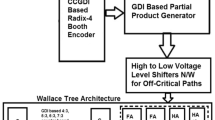Abstract
This paper presents a low power digital multiplier design by taking advantage of a 2-dimensional bypassing method. The proposed bypassing cells constituting the multiplier skip redundant signal transitions as well as computations when the horizontally partial product or the vertical operand is zero. Hence, it is a 2-dimensional bypassing method. Thorough post-layout simulations of a 8×8 digital multiplier using the proposed 2-dimensional bypassing method show that the power dissipation of the proposed design is reduced by more than 75% compared to prior designs. Physical measurements on silicon reveal that the proposed digital multiplier saves more than 28% even with pads’ power dissipation compared to the prior works.









Similar content being viewed by others
References
Choi, J., Jeon, J., & Choi, K. (2000). Power minimization of functional units by partially guarded computation. In 2000 International symposium on low power electronics and design (ISLPED’00) pp. 131–136, July.
Di, J., Yuan, J. S., & Hagedorn, M. (2002). Energy-aware multiplier design in multi-rail encoding logic. In The 2002 45th Midwest symposium on circuits and systems (MWSCAS-2002) (Vol. 2, pp. 294–297), Aug.
Hwang, W., Gristede, G. D., Sanda, P. N., Wang, S. Y., & Heidel, D. F. (1999). Implementation of a self-resetting CMOS 64-bit parallel adder with enhanced testability. IEEE Journal of Solid-State Circuits, 34(8), 1108–1117.
Hong, S., Kim, S., Papaefthymiou, M. C., & Stark, W. E. (1999). Low power parallel multiplier design for DSP applications through coefficient optimization. In 1999 twelfth annual IEEE international ASIC/SOC conference pp. 286–290, Sep.
Ohban, J., Moshnyaga, V. G., & Inoue, K. (2002). Multiplier energy reduction through bypassing of partial products. In 2002 Asia-Pacific conference on circuits and systems (APCCAS ’02) (Vol. 2, pp. 13–17), Oct.
Ahn, T., & Choi, K. (1997). Dynamic operand interchange for low power. Electronics Letters, 33(25), 2118–2120.
Shen, N.-Y., & Chen, O. T.-C. (2002). Low-power multipliers by minimizing switching activities of partial products. In IEEE international symposium on circuits and systems, 2002 (ISCAS 2002) (Vol. 4, pp. IV-93-IV-96), May.
Wang, C.-C., Huang, C.-J., & Tsai, K.-C. (2000). A 1.0 GHz 0.6-μm 8-bit carry lookahead adder using PLA-styled all-N-transistor logic. IEEE Transactions on Circuits and Systems, Part II: Analog and Digital Signal Processing, 47(2), 133–135, Feb.
Kang, J.-Y., & Gaudiot, J.-L. (2006) A simple high-speed multiplier design. IEEE Transactions on Computers, 55(10), 1253–1258.
Wang, C.-C., Tseng, Y.-L., Lee, P.-M., Lee, R.-C., & Huang, C.-J. (2003). A 1.25 GHz 32-bit tree-structured carry lookahead adder using modified ANT logic. IEEE Transactions on Circuits and Systems—I Fundamental Theory and Applications, 50(9), 1208–1216.
Islam, F. F., & Tamaru, K. (1995). High speed merged array multiplication. The Journal of VLSI Signal Processing Systems for Signal, Image, and Technology, 10(1), 41–52.
Acknowledgements
The authors would like to express their deepest gratefulness to CIC of NSC for their thoughtful chip fabrication service. The authors also like to thank “Aim for Top University Plan” project of NSYSU and MOE, Taiwan, for partially supporting this investigation.
Author information
Authors and Affiliations
Corresponding author
Additional information
This research was partially supported by National Science Council under grant NSC96-2628-E-110-018-MY3 and National Health Research Institutes under grant NHRI-EX97-9732EI.
Rights and permissions
About this article
Cite this article
Wang, CC., Sung, GN. Low-Power Multiplier Design Using a Bypassing Technique . J Sign Process Syst Sign Image Video Technol 57, 331–338 (2009). https://doi.org/10.1007/s11265-008-0319-y
Received:
Revised:
Accepted:
Published:
Issue Date:
DOI: https://doi.org/10.1007/s11265-008-0319-y




